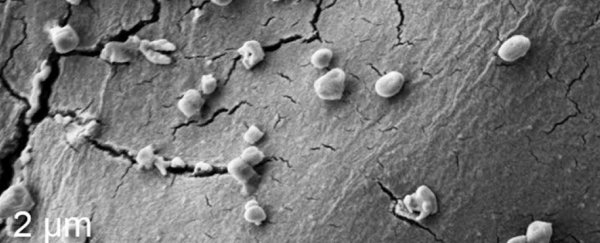The microbe Metallosphaera sedula is known to have a penchant for eating minerals. We're not talking about garden-variety granite or chalk, though. This particular mineral connoisseur loves to dine on far more exotic rocks - ones that come from space.
The discovery of the bacteria-like archaeon's preference for meteorites not only invites speculation on how terrestrial life could survive off world, it offers insight into how early biology could have received key nutrients through space rocks that landed on Earth way back when.
It's fair to assume that life might never have formed on our ancient planet if not for a generous dash of meteorites. They're thought to be the source of rare elements such as phosphorus, for example, not to mention far more complex organic compounds.
So an international team of researchers wondered whether some organisms might have evolved a talent for taking advantage of these rather special mixes of mineral.
The technical term for biology that's capable of using rocks as an energy source is chemolithotroph. Some bacteria, such as Leptospirillum ferrooxidans and Acidithiobacillus ferrooxidans, are already known to oxidise the iron in meteorites.
To find a microbe that might treat meteorites as more than just a side dish, the team turned to a thermoacidophile – a microbe that copes well with heat and low pH – which they'd previously shown could survive in Martian soil.
Their pick, M. sedula, has long had a reputation for weird tastes. In the past, researchers have demonstrated its potential for removing iron sulphide (also known as pyrite, or fool's gold) from coal.
Determining if the metal-loving archaeon might have a hunger for space rocks meant finding a suitable meal, one with a good mix of metals and room to feed and grow. The team selected an ordinary rocky type of meteorite called Northwest Africa 1172 (NWA 1172), a 120-kilogram chunk of mineral uncovered back in 2000.
"NWA 1172 is a multimetallic material, which may provide much more trace metals to facilitate metabolic activity and microbial growth," says astrobiologist Tetyana Milojevic from the University of Vienna.
"Moreover, the porosity of NWA 1172 might also reflect the superior growth rate of M. sedula."
A culture of the archaeon was applied to sterilised slabs of the meteorite, and closely monitored with microscopy and an analysis of the freed metal ions the microbes released as they fed. A sample was also fed on a ground-up mix of the same mineral.
For comparison, similar microbial cultures were fed ground-up samples of the copper-iron-sulphur mineral chalcopyrite.
The two meals produced significantly different growth rates, with the archaeon's numbers peaking far earlier on the meteorite than the chalcopyrite. Whatever specific mixture the meteorite provided, M. sedula was satisfied far quicker.
Closer inspection with other microscopy techniques revealed some clever tricks employed by the microbe. Tiny bubbles were seen outside of the archaea's bodies, which seemed to help catalyse reactions and possibly reduce the toxicity of their meal, for example.
"Meteorite-fitness seems to be more beneficial for this ancient microorganism than a diet on terrestrial mineral sources," says Milojevic.
A chemical and microscopic analysis of the banquet's leftovers presented the researchers with a potential biological signature that could be used in the future to detect whether a meteorite – or other space rocks, for that matter – have been chewed on by a hungry chemolithotroph.
While we gaze into the heavens in hope of finding life that isn't from here, it's becoming clear that microbes that evolved on Earth might already have beat us into space.
Some species can almost certainly survive the extremes of an interplanetary vacuum, leaving the possibility that microscopic astronauts could contaminate other rocky bodies; either by hitching a ride on our technology, or ejected by past impacts.
"Our investigations validate the ability of M. sedula to perform the biotransformation of meteorite minerals, unravel microbial fingerprints left on meteorite material, and provide the next step towards an understanding of meteorite biogeochemistry," says Milojevic.
If we're to have a sound understanding of tiny hitchhikers surviving, if not thriving, in space, we're going to need to know more about how they might get a good feed.
This research was published in Scientific Reports.
